|
|

Click Here to Return to the First Coston Page
Martha Coston:
A Woman, a War, and a Signal to the World
~ by Denise E. Pilato, Eastern Michigan University ~
Martha J. Coston (1829-1904), was an inventor and successful businesswoman during the second half of the 19th century. She made her mark with one invention, which she wrote about in her one book, an autobiography, A Signal Success. Although obscured in traditional history, her singular invention is not invisible, but marks maritime history in significance, widespread application, and longevity. Like her invention, her story, buried deep in the archives of history, resonates with significance more than a century later. Her invention and relationship to the U.S. Navy during the Civil War represents the early chapters of her remarkable story.
Her invention, a pyrotechnic night signal flare and code system, was first successfully used by the U.S. Navy during the Civil War. After the War, the United States Life Saving Service, forerunner of the United States Coast Guard, used the flare extensively well into the 20th century. Her manufacturing company began in 1859 and survived until at least 1985, possibly longer.[1] Additionally, the U.S. Weather Service, military institutions in England, France, Holland, Italy, Austria, Denmark, and Brazil, commercial merchant vessels, and private New York Yachting Clubs all adopted the Coston Signal Flare and code system.
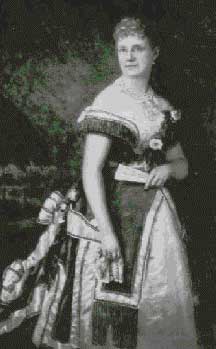
Portrait of Martha Coston
| |
|
|
|
Martha was born in Baltimore, Maryland, and moved to Philadelphia with her widowed mother, brothers, and sisters sometime during her childhood in the 1830s. At the age of 16, perhaps even a bit younger, she married Benjamin Franklin Coston, a promising young inventor who had already developed a working prototype of a submarine that could be “navigated eight hours under water.” [2]
The young Coston couple lived a seemingly charmed life. Benjamin was appointed Master in the Naval Service by Secretary of the Navy, George Bancroft, and placed in charge of the Naval Laboratory in the Washington Navy Yard. During this time, he was instrumental in the development of Hale’s Rocket and a cannon percussion primer.[3] A dispute arose over compensation for the Navy’s use of his cannon percussion primer, which eventually led to Coston’s resignation in August 1847.[4] Thereafter, he accepted the position of president of the Boston Gas Company, where he perfected and manufactured the Sylvic Gas Light. By this time, Coston already experienced the affects of serious health hazards by constant inhalation of chemical gases used in experiments while at the Navy Yard. His process of generating gas from rosin further aggravated his
conditioned. [5] Although his accomplishments with gas lighting were hailed as a major success in both home and commercial lighting, the toxic effects of chemical processing proved fatal to Benjamin F. Coston. He died on November 24, 1848, leaving behind a widow with four small children.
Martha’s personal tragedy continued over the next two years as she lost first her infant son, then her mother, than yet another son. These devastating tragedies left her in poor emotional, physical, and financial straights. Although an educated woman for her time, Coston’s education proved wholly inadequate for what was soon to become her life’s work, the business of invention.
Shortly after her husband’s death, she admitted that “through her own ignorance and the duplicity of others,” particularly a relative who “misplaced” her money, she found herself penniless. She “did not know how to dig” and was “ashamed to beg.” In this state on a gloomy November afternoon, deeply depressed, she began sorting through her husband’s papers. She discovered “numerous packets, carefully sealed and labeled,” one of which contained drawings for a pyrotechnic night signal. [6] She recalled that her husband worked on this invention while at the Washington Navy Yard and had given a test set of the signals to a particular naval officer for later testing. Contact with this officer proved difficult and the return of the signal flares problematic. Eventually he begrudgingly returned the damaged box of signals without any documentation as to the "written recipes for their manufacture.” [7]
This began one of the most challenging “testing” periods of her life, calculated in both personal and professional measures. Coston used her Washington D.C. social and U.S. Navy connections forged during her marriage to pursue what she considered the one hope for her whole future. With desperate determination, she approached the current Secretary of the Navy, Isaac Toucey, about having the signals tested. To her relief, “he readily consented to a trial of the signals,” giving her the option of choosing where the signals would be tested. She requested that tests be carried out in the Home Squadron, which fell to the flagship Wabash under Commodore (afterwards Admiral) Paulding. At the conclusion of the testing period, Coston received a letter from Paulding, informing her that “the signals proved utterly good for nothing.” Paulding also mentioned in the letter that he thought the signals a very good idea and encouraged continued work to perfect the invention. He did not want the record to reflect that he was “the one who put her lights out.” [8]
Upon receiving the adverse report, Secretary Toucey remained loyal to the idea and offered Coston the use of the Washington Navy Yard and its talent to perfect the invention. She accepted his offer. After six months, another test was executed, again with dismal results. In addition to Coston’s extremely limited pyrotechnic and chemistry knowledge, hints surfaced of lingering political animosity against Coston’s husband over the use of the percussion primer by the U.S. Navy. [9] The Yard was under the direction of John A. Dahlgren (later famous for his ordnance developments) and his staff, some of who were associated with the percussion primer incident. But there were other Navy personnel, in particular Secretary Toucey, who steadfastly continued to believe “that the invention if properly carried out would be of incalculable service to the government.” [10]
Still, it was with a bitter edge that Coston recaps this “testing” part of her life. She wrote,
It would consume too much space, and weary my readers, for me to go into all the particulars of my efforts to perfect my husband’s idea. The men I employed and dismissed, the experiments I made myself, the frauds that were practiced upon me, almost disheartened me; but despair I would not, and eagerly I treasured up each little step that was made in the right direction, the hints of naval officers, and the opinions of the different boards that gave the signals a trial. [11]
The testing period of her life consumed nearly ten years of experimentation to perfect the “recipe” for a flare that burned red, white, and blue. Coston’s reference to the men she employed, the experiments she made herself, and the frauds practiced upon her represent some of the most trying obstacles. Because she did not possess knowledge of chemistry, scientific experimentation methodology, or an understanding of business, she had to rely on those who had such knowledge, all of whom were men. Based on gender alone, she felt ignored, not taken seriously, and sometimes deceived. [12]
Still she persevered, treasuring the support she did have, and finally experienced a breakthrough while watching the New York celebration of the laying of the first transatlantic cable in 1858. After viewing the spectacular fireworks, she began corresponding with several of the New York pyrotechnists in hope of getting a strong blue as a third color to be used with the red and white that she already developed. She corresponded under a man’s name fearing that they would not give heed to a woman. One man replied that he had made a blue color some years previous. Coston urged him to duplicate the blue, but if not she would be interested in a strong green. Within ten days, she received a package containing a strong green color. In the end, her desire for the patriotic red, white, and blue could not be achieved with the same clarity and brilliance as green. Coston immediately entered negotiations to work with this New York pyrotechnist.
Coston’s motivation and strength during this time was much the same as any inventor, male or female. She was interested in making money. It was a matter of survival for her and her children. And not unlike other inventors, a spirit of national patriotism also motivated her. She characterized herself as an exemplary patriot and humanitarian, especially in the looming portent of a Civil War. In the preface of her autobiography, A Signal Success, she wrote with stirring emotion and typical Victorian voice, that it was her “intense and heartfelt desire to accomplish something for the good of humanity.” [13] She finally presented her accomplishment to the world on April 5, 1859, in the form of Patent No. 23,536, a pyrotechnic night signal and code system.
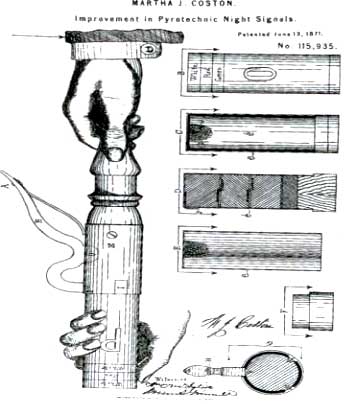
Coston's pyrotechnic night signal
June 13, 1871 Patent
| |
|
|
|
The patent was granted to Martha J. Coston as administratrix of B. Franklin Coston, but the patent clearly states B. Franklin Coston as the inventor although he had been dead for more than 10 years. [14] Her next patent in 1871 was patented entirely under her own name
There are several reasons why she may have patented first in her deceased husband’s name and subsequently in her own. The strongest evidence supports that this was a business decision, calculated to benefit from the established reputation and name of a known successful Navy inventor. Coston pays attention to appropriate feminine protocol and Victorian female conduct inconsistently, but does so most noticeably when it furthers business interests.
By 1859, the success of the signal was well documented by a specially appointed board of Naval Examiners by Secretary Toucey. After a month long testing period, a report was published in February, 1859. In brief summary, the report contained three main points: (1) Coston signals are better than any other known to them; (2) the Board strongly recommend them for the use of the navy; and (3) Signals being the means whereby orders are given, or wants made known at sea, a good code of them plainly intelligible to the persons addressed is absolutely necessary to the efficient conduct of a fleet. The current “night signals were arranged in a separate code, of little extent, and of uncertain determination.” The report concluded with full endorsement: “The Application of the “Coston night signals” to the navy day signal books gives a perfect code of night signals. They offer precision. fullness, and plainness, at a less cost for fireworks than it is thoughtwe now pay for confusion and uncertainty.” In the opinion of the Board of Examiners,Capt. Charles McCauley, Commander John Rogers, and Lt. Henry Lewis, the signals were “decidedly superior.” [15]
Still, the Navy did not purchase the patent. During the next two-year period from 1859 until the beginning of the Civil War in 1861, the U.S. Navy beset the purchase of the patent with delay and stall tactics. The Navy continued to buy large orders of sets, each set consisting of 12 flares. Per direction of Secretary Toucey, D.N. Ingraham, Chief of the Bureau of Ordnance, ordered at least 300 sets in March of 1859. Within a short time, the Navy had placed its first order of $6,000 (small size at $4 per set and the large size at $7 per set). These signals were divided for use between the North and South Atlantic, the North and South Pacific, and the African fleets. [16] While the issue of purchasing the Coston patent was under debate in Congress, Coston made an aggressive business decision to market her flares in Europe. She set sail for England with her two small sons in August, 1859. Before leaving for Europe, she secured patents in England, France, Holland, Austria, Denmark, Italy, and Sweden. [17] Coston remained in Europe until 1861, traveling back and forth between London and Paris occupied in negotiations with the British and French governments for the purchase of her patent.
When the Civil War finally broke out in earnest, Coston returned home from England in the summer of 1861, and went directly to Washington D.C. to push the bill before Congress for the sale of the patent. She firmly believed that her signals would prove a “valuable auxiliary” for the Navy and “the night would lose half its terrors at sea, when in the darkness and through the storm ships could talk to each other.” Although Congress still had not purchased her patent, Coston’s factory quickly furnished flares to the first 600 vessels the Union could outfit. [18] Congressional delay in purchasing the patent was due in large part to some powerful opponents in the War Congress who generally opposed the purchase of patents by the government. While success was begrudged, it was not totally denied. Finally, authorized by an Act of Congress on August 5, 1861, the U.S. Navy acquired the patent. Coston originally asked $40,000, the Senate reduced it to $30,000, and finally she got $20,000 for the patent. [19]
During the Civil War the Coston Manufacturing Company continued to manufacture and supply the signals at cost to the Navy, which meant selling at a loss due to wartime inflation of the cost of materials. Although the Navy tried to produce the flares themselves, they were unable to do so at a cost lower than Coston could manufacture. Numerous letters and requisitions document the extensive use of the Coston signal flare between 1861 and 1865 by the U.S. Navy. [20] Congressional records dated until as late as 1876 document the repeated attempts by Coston to get compensation promised her by the Navy for selling the flares at cost for most of the Civil War.
By 1875, her claims remained unsettled. Interesting details surfaced during the 2d Session of the 43rd Congress. The Honorable William Faxon, a former Assistant Secretary of the Navy, wrote a letter to Coston, dated January 15, 1875, stated in part that,
It was the universal testimony of the officers of the navy that the signals were of greatest possible service—indispensable, in fact—and always thought that you were very patriotic in continuing to furnish them at gold prices, taking pay in largely depreciated paper. After the patent was purchased an attempt was made to manufacture the signals in the Navy-yard, but they cost more than your prices.
The report continued in the acknowledgement that approximately 100,000 sets (1,200,000 flares) were furnished by Coston to the Navy during War. It was estimated that $120,000 was due to her. The government offered her $15,000. It is not surprising to hear again a bitter tone when she wrote years later about this experience,
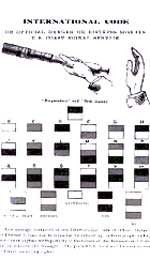
Coston’s International
Signal Code
| |
|
|
|
We hear much of the chivalry of men towards women; but let me tell you, gentle reader, it vanishes like dew before the summer sun when on of us comes into competition with the manly sex. . .To me it was a most bitter thing to find in that lofty institution of our country, the navy, men so small-minded that they begrudged a woman her success, though achieved after long years of struggle and patient industry. And this notwithstanding the fact that many of the officers had been benefited personally by the use of the signals, --for not a few of them were made rich through prize-money won by capturing the blockade-runners at night, which they did not do in a single instance without the aid of the Coston Signals. [21]
Coston’s claims of successful application of the signal flare and code system during the Civil War by the U.S. Navy are solidly documented in numerous letters, ship logs, code documents, and purchase orders. Two of the most interesting documented applications occurred in the capture of blockade-runners and during the Battle of Fort Fisher by the North Atlantic Squadron.
Coston herself claims that “nearly all the blockade-runners were caught by their use [the signal flare], as they generally made their runs by night, and the United States navy vessels’ gave chase after communication with each other by means of the signals.” [22] She was well aware of the large prize money that resulted in the capture of Confederate runners to not only the Union government but also to individual officers. Specially appointed prize courts reviewed papers, cargo, and interviewed witnesses on a case-by-case basis. [23] The National Archive, Record Group 45, Naval Records Collection of the Office of Naval Records and Library, provides specific documentation of the widespread use of the Coston Signal Flare by the North Atlantic Blockading Squadron, the East Gulf Blockading Squadron, and the Western Gulf Blockading Squadron.
For example, in 1864, while engaged in the Mobile Blockade, Captain T. A. Jenkins, of the commanding division of the Western Gulf Blockading Squadron issued instructions for night service entitled “Night Distinctions for Vessels and Special and Other Night Signals for the Blockade off Mobile, January 25, 1864.” This special set of instructions was not to be incorporated in the Naval General Signal Book except in pencil and only for this particular blockade operation. Of particular interest in that set of instructions is Number 5, “Special Night Signals,” which states, “To be used only by Picket Boats and by all vessels on the Mobile Blockade. The following Coston Lights to be burned without the preparatory signal being made.” This general instruction is followed by 10 specific points including such vital communication as “strange sail running out of the pass,” “suspicious movements of the enemy ironside,” and “in need of assistance.” The Mobile Blockade records discussing the Coston signal include telegrams, communication from specific ships, and printed Circulars from the Bureau of Navigation. [24]
An interesting piece of correspondence from J.F. Green, Captain and Senior Officer of the U.S. S. John Adams off Morris Island, S.C. underscores the vital role that Coston Signals played in the serious business of capturing blockade runners. On October 27, 1864, Green writes to Lt. Commander E.O. Matthews, Commanding Naval Battery:
Sir: I have concluded to furnish the army with the navy night signals for “Rams in sight and near” and “Blockade runners going out.” Signals as follows:
“Rams in sight and near”. One rocket followed by Coston’s No. 7.
“Blockade runner going out”. One rocket followed by Coston’s No. 0.
Very respectfully, your obedient servant,
J.F. Green,
Captain and Senior Officer, off Charleston
[25]
Perhaps one of most famous accounts of the important significance of the Coston night signal is during the Battle of Fort Fisher, January 13-15, 1865. General Order No. 78, January 2, 1865, issued by Rear Admiral David D. Porter, Commander of the North Atlantic Squadron, maps out the strategic movement of Navy vessels for the bombardment of Fort Fisher. Giving specific orders as to the formation of the first and second lines of battles, there is no mistaking the directives that “all these things will be regulated by signal.” A combination of different types of signals were used, primarily flags, whistles, and Coston flares. [26] The ship logs of the leading three vessels in Battle Line No. 2, the Minnesota, the Colorado, and the Wabash suggest the complicated strategic goals of the operation and the important part that Coston signals played in the capturing of Fort Fisher. The drama begins to unfold during the early morning of January 13, 1865. From the log of the Wabash: “At 4:30 a.m. Admiral made Gen’l Signal 7218 by Coston lights. At 5 got underway and formed in line of Battle. Standing in shore. At 6:40 Flag Ship made Gen’l Signal (BC) 757-1281-Went to quarters at 7.” [27]
The logs of all three ships detail the calculated movement, progress of the battle, and the orchestration of organizing and moving numerous vessels into position and action by use of signals, significantly relying on the Coston signal at night and when the air became filled with heavy dark smoke at the height of the firing. After three days of intense bombardment, Fort Fisher fell on January 15th.
While writing her autobiography many years later, Coston received a letter from Admiral David D. Porter, commanding officer of the Fort Fisher attack, detailing the role the Coston Signal played in the Battle of Fort Fisher. In reference to Fort Fisher in the concluding paragraph of his letter, he wrote:
I shall never forget the beautiful sight presented at ten o’clock at night when Fort Fisher fell. I was determined to be a little extravagant on that occasion, and telegraphed by the signals to all creation that the great fort had fallen and the last entrance to the Southern coast was closed. The order was given to send up rockets without stint and to burn the Coston Signals at all the yard-arms, mast-heads, along the bulwarks, and wherever on shipboard a light could show. The sea and shore were illuminated with a splendor seldom equalled [sic]. . .
What could there be more beautiful than the Coston signals on that occasion, and what more could I say of them?
Yours truly and respectfully,
David D. Porter
Admiral U.S. Navy
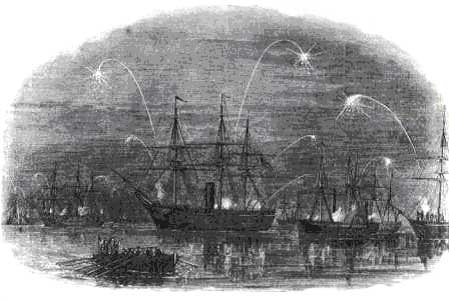
Celebration of the fall of Fort Fisher
| |
|
|
|
In addition to Admiral Porter’s praise of the signal’s usefulness, Coston also received correspondence from Admirals Farragut, Rogers, Trenchard, Smith, and Paulding. [28]
In fitting acknowledgement of the U.S. Navy’s use of her signal flare, Coston singles out Admiral Joseph Smith in her dedication of a Signal Success. It reads, “To the Late Admiral Joseph Smith, U.S.N., Washington D.C., Many years Chief of Bureau of Yards and Docks, U.S. Navy Department, This Book is Dedicated as a token of Gratitude and Affection.” Her warm friendship with Admiral Smith is noted once again in her Last and Will and Testament. She explicitly bequeaths to one of her grandson’s, Spencer W. Coston, a gold-headed cane that was left to her by Rear Admiral Joseph Smith, a cane, which she says, had been carried by Smith for 20 years. Her relationship with the U.S. Navy was explicitly a business one, but it is worth noting that it penetrated her personal life as well.
As research continues, further documentation of Martha J. Coston’s relationship with the U.S. Navy will certainly come to light detailing her contributions during the Civil War. Coston considered her contributions to the U.S. Navy among the most important of her life. As her story unfolds, it is clear that it was not the only accomplishment that merits recovery. After the Civil War, the Coston Signal, continued in widespread use by many foreign governments, commercial merchants, private yachting clubs, and most significantly by the U.S. Life Saving Service. It is not only her accomplishments as a businesswoman and inventor that present a fascinating portrait. Her character reveals insights into a chapter of American history that has yet to be documented, the professional American woman inventor. Martha J. Coston’s signal and story may indeed still function as a signal to the world, one that communicates the contributions of many professional women inventors that followed in her path.
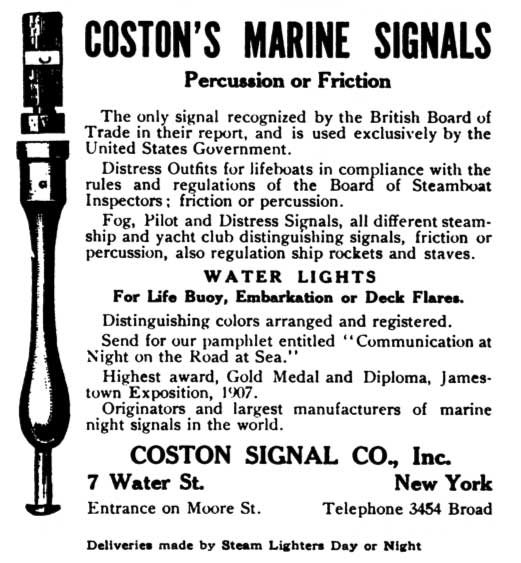
Coston Flare 1913 Advertisment
| |
|
|
|
Additional Readings:
Coston Signal Secret -New York Times 8-19-1901
Laila Ann Coston "Letter to the Editor" 7-29-1915
Percussion Signal Pistols Info. - armscollectors.com
[1] Beginning in 1913, The Directory of Directors in The City of New York includes a listing for Coston’s company consistently until 1985. In 1927 the name was changed from Coston Signal Company to Coston Supply Company, but still operating in New York City. Recent evidence indicates that the company my have been sold sometime after 1985 rather than have gone bankrupted, but that is not confirmed at this time. In 1985 the company’s business was still listed as “marine night signals & rockets, ships supplies, marine equipment.” Directory of Directors in the City of New York. Directory of Directors Company 1913–1985.
[2]Coston writes in her autobiography that she married Benjamin F. Coston in the spring at the age of 16 years, which would have been in 1845 (b. 1829, d. 1804). Benjamin’s date of death is recorded as November 24, 1848. The discrepancy arises with later information that indicates she was married for five years during which four children were born. This discrepancy merits further research to discern whether the date of her marriage may have been earlier or her husband’s death date later. Sixteen was certainly an early age to be married, but not all that unusual. To be married at 13 or 14 would surely have incurred scandal, one to be avoided by any proper Victorian woman. Martha J. Coston, A Signal Success. The Life and Travels of Mrs. Martha J. Coston (Philadelphia, PA: Lippincott Company, 1886), 11.
[3] Coston, A Signal Success, p. 14; Andrew F. Lustyik, “A History of Military Pyrotechnics, Part I,” The Gun Report, (April, 1968): 10.
[4] B.F. Coston refused to surrender to the U.S. Navy the secret of the composition of the percussion primer. Upon direct request to do so, he stated that he considered the composition of the caps “as my private property, as much so as the reminder of my private recipes.” He did, though, agree to full any orders that the U.S. Navy might wish to place with him for the manufacture of caps. Letter from B.F. Coston to Commodore J.H. Aulick, Commander of the Yard, Feb. 2, 1846 as quoted in Lustyik, "Part I,” 11.
[5] Coston, A Signal Success, 27; Coston’s Telegraphic Night Signals Patented in the United States and Europe, and Adopted by the governments of the United States, France, Italy, Denmark, Holland, Hayti, and the New–York, Brooklyn, and Eastern Yacht Clubs; used in the U.S. Revenue, Marine, Life–saving and Light–house Services; Diploma of Merit (Vienna, 1873; New York: S.W. Green [1880] ).
[6] Coston, A Signal Success, 37–38.
[7] Lustyik, “Part I”, pp. 11–12; Coston, Ibid., 40.
[8] Coston, Ibid., 42.
[9] As mentioned in Note 4, B.F. Coston encountered problems regarding his percussion primer. Because the U.S. Navy never bought this patent, but continued using it, legal and financial issues dragged on. It was not until June 13, 1873, when Secretary of the Navy, George M. Robeson made known that the results of an ongoing investigation by William N. Jeffers, Chief of the Navy Ordnance Bureau, which revealed that 2,662,360 percussion caps had been manufactured by the U.S. Navy between 1847 and 1873. It was ultimately determined by Congress to award Martha Coston $13,000 for the use of her husband’s percussion primer by the U.S. Navy. Lustyik, “Part II,” 26, 28.
[10] Coston, A Signal Success, 43.
[11] Coston, Ibid., 43–44.
[12] Denise E. Pilato, The Retrieval of a Legacy: Nineteenth Century American Women
Inventors (Westport, CT: Praeger, 2000).
[13] Coston, A Signal Success, 3.
[14] United States Patent Office. Official Gazette, Letters Patent No. 25, 536 (April 5, 1859), 325.
[15] Coston’s Telegraphic Night Signals.
[16] Letter from Isaac Toucey to Capt. Ingraham, March 19, 1859; Letter from Martha Coston to Isaac Toucey, March 11, 1859; National Archives, Record Group 45, “Naval Records Collection of the Office of Naval Records and Library, 1775–1927”; Coston, A Signal Success, pp. 52–54; Lustyik, “Part I,”14.
[17] Coston, A Signal Success, 60.
[18] Coston, Ibid., 84, 88.
[19] In the 37th Congress, 1st Session, it was requested by the Secretary of the Navy, Gideon Welles, that “grant of $30,000” should be appropriated for the purchase of the Coston patent. He supports his request with the evidence based on successful trials by boards of naval officers and concluded that these “lights were almost indispensable to the service” (July 26, 1861). The House of Representatives granted the appropriation in the amount of $30,000. Shortly thereafter, the Senate reduced the amount to $20,000. See also United States Congressional Publications, 43rd Congress, 2d Session, Report No. 334, March 3, 1875; Coston, A Signal Success, 90.
[20] National Archives, Record Group 45.
[21] Coston, A Signal Success, 271–273.
[22] Coston, Ibid., 97.
[23] Typically, the government kept half of the money. The commander of the regional blockading squadron received five per cent, and the local squadron commodore received one per cent. The remaining amount was divided into 20 equal shares. Those portions were divided as follows: three to the captain of the capturing ship; ten shares to the officers and midshipmen; remaining seven divided among the enlisted men Some got rich, including high ranking officers. Of particular interest, Admiral David D. Porter, commanding officer of the attack on Fort Fisher and one who was very familiar with the use of the Coston flare and code, reportedly collected over $91,000 in prize money (Gerald Simons, Ed. The Civil War: The Blockade, Runners and Raiders (Alexandria, VA: Time–Life Books, 1983), 91; Robert J. Schneller, Jr., Under the Blue Pennant or Notes of a Naval Officer (New York: John Wiley & Sons, 1999), 29–31,115–117.
[24] National Archives, Record Group 45, Boxes 161, 162.
[25] National Archives, Ibid., Box 161.
[26] National Archives, Ibid., Box 186.
[27] National Archives, Record Group 24, Log of Ships and Stations.
[28] Coston, A Signal Success, 100, 101.
|
































